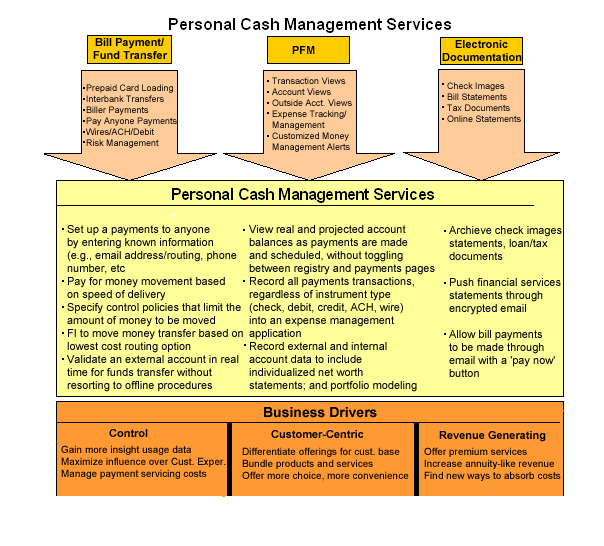| San Francisco, CA, USA July 13, 2005 Celent reveals that bill payment processors, online banking providers and third party technology vendors all have plans to offer a full suite of applications that enable banks to offer a holistic set of financial management and payment services that Celent terms Personal Cash Management Services (PCMS).
In a new report, " ," Celent describes the business drivers behind Personal Cash Management Services (PCMS) and how the various components underpinning the service come together. When examining bills pay trends, we found that convergence is the next wave. The new generation of online banking services to be rolled out within the next year will uniquely combine funds transfer, aggregation, personal financial management (PFM) services and bill payment.
According to Dan Schatt, senior analyst at Celent and author of the report, "The rise of PCMS stems from underlying industry drivers that stress control, customer-centric services and revenue-generating opportunities. As a result, we see new competitive dynamics emerging as banks exert further control over their cost structure and revenue. This will encourage new alliance structures among processors and email providers, credit scoring companies and PFM Lite application providers and we will likely see more direct competition develop between CheckFree and a host of online banking service providers to become the full provider of PCS Services."
Among the key findings:
- The online channel now accounts for 20 percent of bill payment volume. By 2007, the share of bill payments made at a biller Web site will grow to 13 percent from 9 percent today, while the share of payments made at a bank Web site will grow to 16 percent from 11 percent today. As usage continues to grow, early mover banks will continue to look for ways to enhance the value of their offerings by integrating more services and functionality.
- 70 percent of PFM users regularly use only 30 percent of the softwares total functionality. The 30 percent that is regularly used we term "PFM Lite." This includes expense management, budget tracking and account viewing services. We see banks and their vendors incorporating PFM Lite services as part of the banks online channels as a way to generate more premium, customer-centric services.
- Payment Warehousing is no longer an all-or-nothing value proposition for banks. Increasingly, top banks are turning to their online banking provider for various aspects of their bill pay service As of 2004, fifty-five percent of top banks relied on their online banking provider for their bill pay user interface, up from twenty-five percent in 2000. Sixty percent license a payment warehouse from an online banking provider, up from twenty percent in 2000. Banks will continue to look to these solutions to control payment costs and capture consumer payments data that can provide greater insight into the customer experience.
- The trend toward free bill pay continues, with seven of the top 10 banks now offering the free service. The pressure to turn these applications into direct revenue has yielded some new interchange generating bill pay products.
- Email has once again become a viable channel for billing communication and payment, now that some vendors have determined ways to overcome phishing tactics and make document encryption more user-friendly. This will become an increasingly important channel for banks as they roll out more sophisticated PCMS such as alerting and for billers that will use the channel to facilitate bill payment.
 The 54-page report contains 24 figures and 4 tables.
A table of contents is available online.
|
of Celent's Retail Banking research service can download the report electronically by clicking on the icon to the left. Non-members should contact info@celent.com for more information. |


